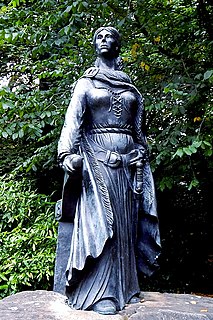
Grace O'Malley, also known as Gráinne O'Malley, was the head of the Ó Máille dynasty in the west of Ireland, and the daughter of Eóghan Dubhdara Ó Máille.

Connacht, or Connaught, is one of the provinces of Ireland, in the west of Ireland. Until the ninth century it consisted of several independent major Gaelic kingdoms.

Lough Corrib is a lake in the west of Ireland. The River Corrib or Galway River connects the lake to the sea at Galway. It is the largest lake within the Republic of Ireland and the second largest on the island of Ireland. It covers 176 km² and lies mostly in County Galway with a small area of its northeast corner in County Mayo.

Connemara (Irish: Conamara[ˌkʊnˠəˈmˠaɾˠə]) is a region on the Atlantic coast of western County Galway, in the west of Ireland. The area has a strong association with traditional Irish culture and contains much of the Connacht Irish-speaking Gaeltacht, which is a key part of the identity of the region and is the largest Gaeltacht in the country. Historically, Connemara was part of the territory of Iar Connacht. Geographically, it has many mountains, peninsulas, coves, islands and small lakes. Connemara National Park is in the northwest. It is mostly rural and its largest settlement is Clifden.

Lough Mask is a limestone lake of about 83 km2 (32 sq mi) in Counties Mayo and Galway, Ireland, north of Lough Corrib. Lough Mask is the middle of the three lakes, which empty into the Corrib River, through Galway, into Galway Bay. Lough Carra flows into Lough Mask, which feeds into Lough Corrib through an underground stream which becomes the River Cong.

William de Burgh was the founder of the House of Burgh in Ireland and elder brother of Hubert de Burgh, 1st Earl of Kent and Geoffrey de Burgh, Bishop of Ely.

West Connacht was a kingdom of Gaelic Ireland, associated geographically with present-day County Galway, particularly the area known more commonly today as Connemara. The kingdom represented the core homeland of the Connachta's Uí Briúin Seóla kindred and although they ruled, there were smaller groups of other Gaels in the area, such as the Delbhna Tir Dha Locha and the Conmhaícne Mara. It existed from 1051 onwards, after the Ó Conchobhair, Kings of Connacht, pushed the Ó Flaithbheartaigh to the West of Lough Corrib, from their original territory of Maigh Seóla. Iar Connacht remained a subordinate túath of Connacht, until the 13th century, after which it was more independent.
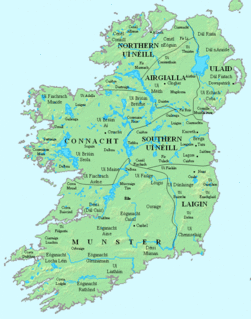
Maigh Seóla, also known as Hy Briuin Seola, was the territory that included land along the east shore of Lough Corrib in County Galway, Ireland. It was bounded to the east by the Uí Maine vassal kingdom of Soghain and extended roughly from what is now Clarinbridge in the south to Knockmaa Hill in the north. Its rulers belonged to the Uí Briúin Seóla and are sometimes found in the annals under the title "King of Uí Briúin" and "King of South Connacht". The earliest identifiable kings belonged to the line that became the Clann Cosgraigh. However in later times the line which would become the Muintir Murchada, under the O'Flaherty chiefs, monopolized the kingship.
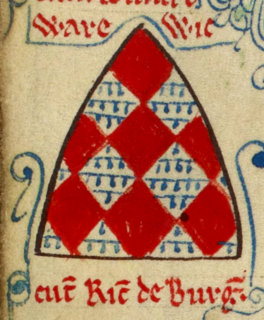
Richard Mór de Burgh, 1st Lord of Connacht, was a Anglo-Norman aristocrat who was Seneschal of Munster and Justiciar of Ireland (1228–32).

O'Flaherty, is an Irish Gaelic clan based most prominently in what is today County Galway. The clan name originated in the 10th century as a derivative of its founder Flaithbheartach mac Eimhin. They descend in the paternal line from the Connachta's Uí Briúin Seóla. They were originally kings of Maigh Seóla and Muintir Murchada and as members of the Uí Briúin were kinsmen of the Ó Conchubhair and Mac Diarmada amongst others. After their king Cathal mac Tigernán lost out to Áed in Gai Bernaig in the 11th century, the family were pushed further west to Iar Connacht, a territory associated with Connemara today. They continued to rule this land until the 16th century. The name has been alternatively rendered into English in various forms, such as Flaherty, Faherty, Laverty, Flaverty, Lahiff, and Flahive.
Galway, one of the largest cities in Ireland, situated on the west coast of Ireland, has a complex history going back around 800 years. The city was the only medieval city in the province of Connacht.

Cong is a village straddling the borders of County Galway and County Mayo, in Ireland.
The city of Galway Ireland was built as a naval base and military fort by Tairrdelbach mac Ruaidri Ua Conchobair in 1124, refounded as a military outpost and town by Richard Mor de Burgh in 1230 - has been subjected to a number of battles, sacks and sieges. This article enumerates the history of military conflict in Galway.

Dunmore is a town in County Galway, Ireland. It is located on the N83 national secondary road at its junction with the R328 and R360 regional roads.
Castlegar is a village and Roman Catholic parish in County Galway, Ireland, located just outside the city of Galway. It extends from Lough Corrib across to Merlin Park by the old Galway-Dublin road. The annual Galway Races are held at Ballybrit Racecourse in the area.
Corr na Móna is a village and townland in County Galway, Ireland. It is part of the Gaeltacht in Joyce Country, and of the possible future geopark.
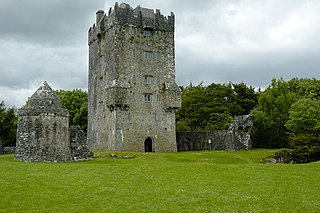
Aughnanure Castle is a tower house in Oughterard, County Galway, Ireland. It is situated in the west of Ireland. It was built by the O' Flaherty's in the 16th century.
Annaghdown is a civil parish in County Galway, Ireland. It takes its name from Eanach Dhúin, Irish for "the marsh of the fort". It lies around Annaghdown Bay, an inlet of Lough Corrib. Villages in the civil parish include Corrandulla and Currandrum. Annaghdown is also an ecclesiastical parish in the Roman Catholic Archdiocese of Tuam and the Church of Ireland Diocese of Tuam, Killala and Achonry.
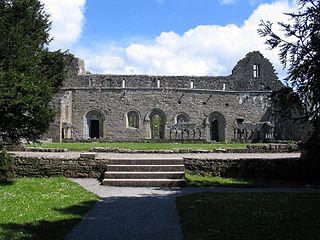
Cong Abbey also known as the Royal Abbey of Cong, is a historic site located at Cong Mayo, in Ireland's province of Connacht. The ruins of the former Augustinian abbey mostly date to the 13th century and have been described as featuring some of finest examples of medieval ecclesiastical architecture in Ireland.
Morogh Ó Flaithbheartaigh was King of Iar Connacht and Chief of the Name.















